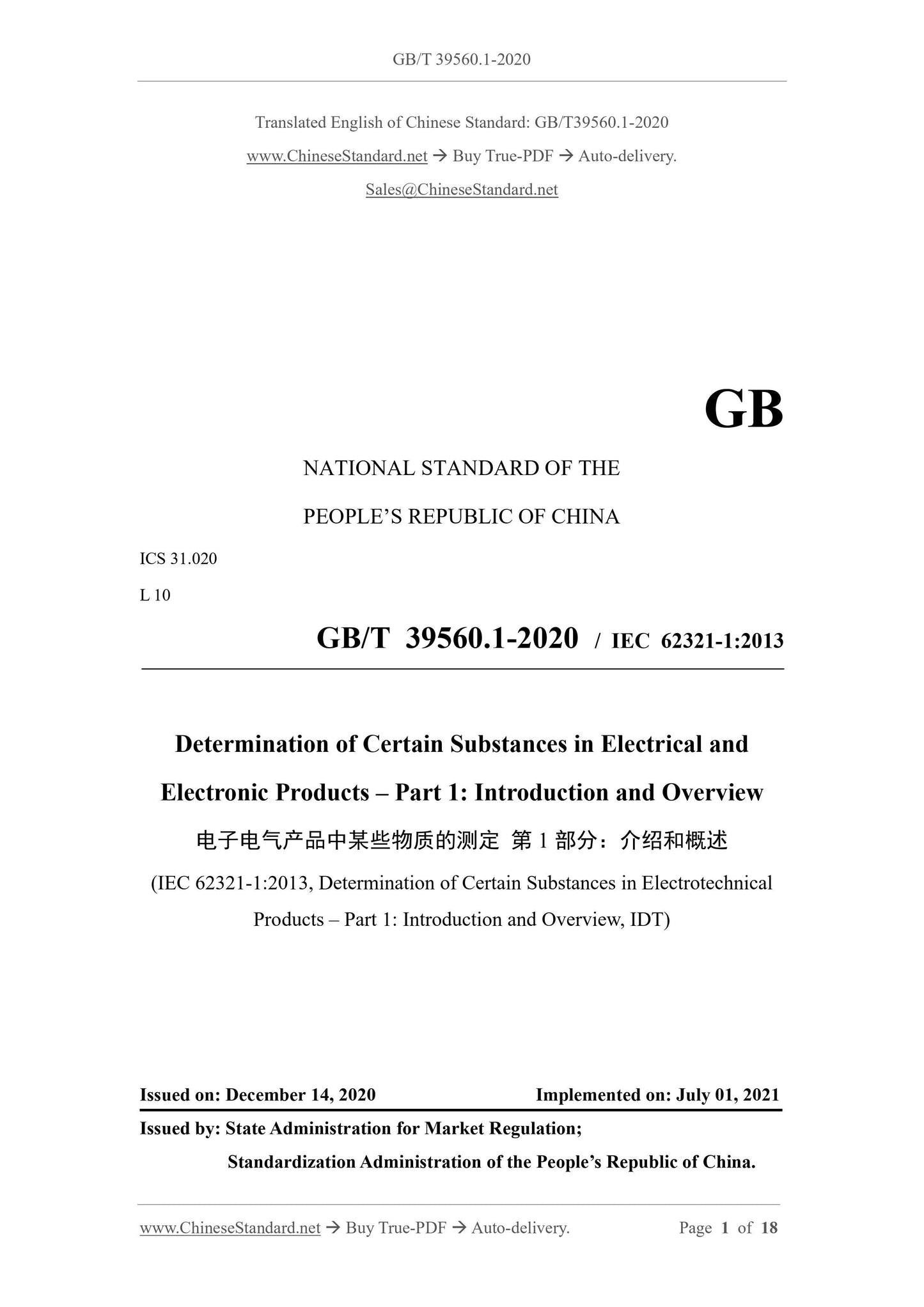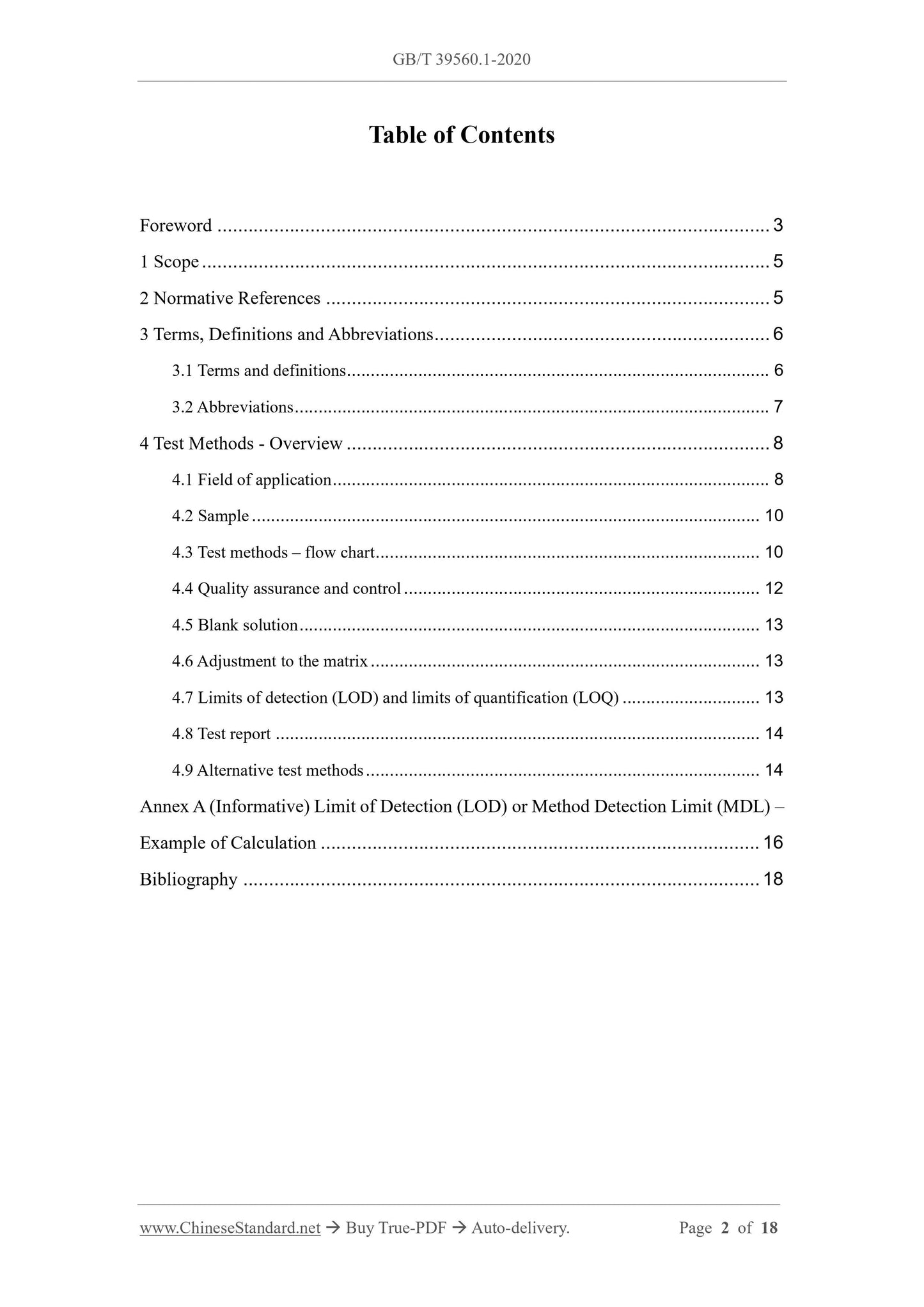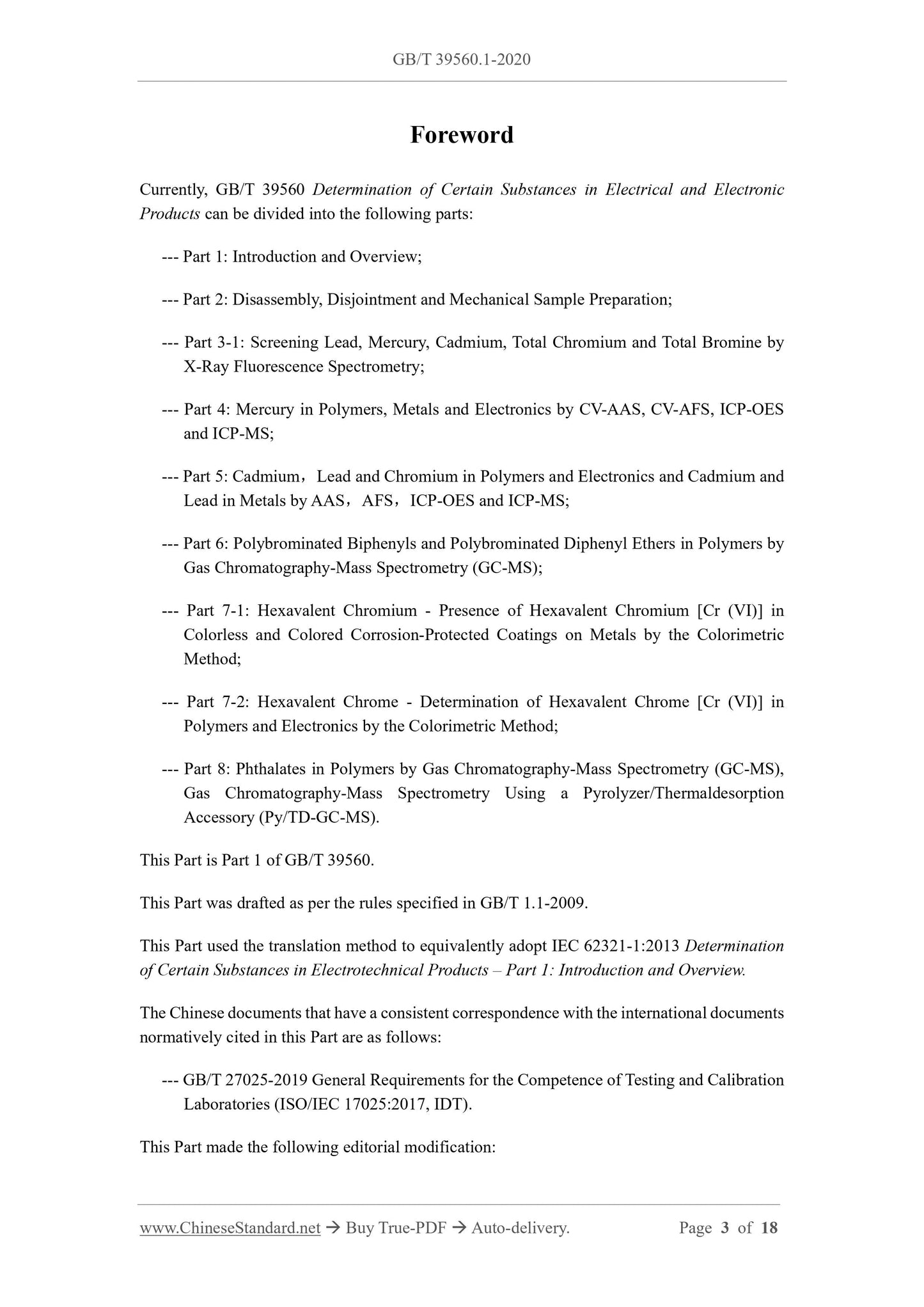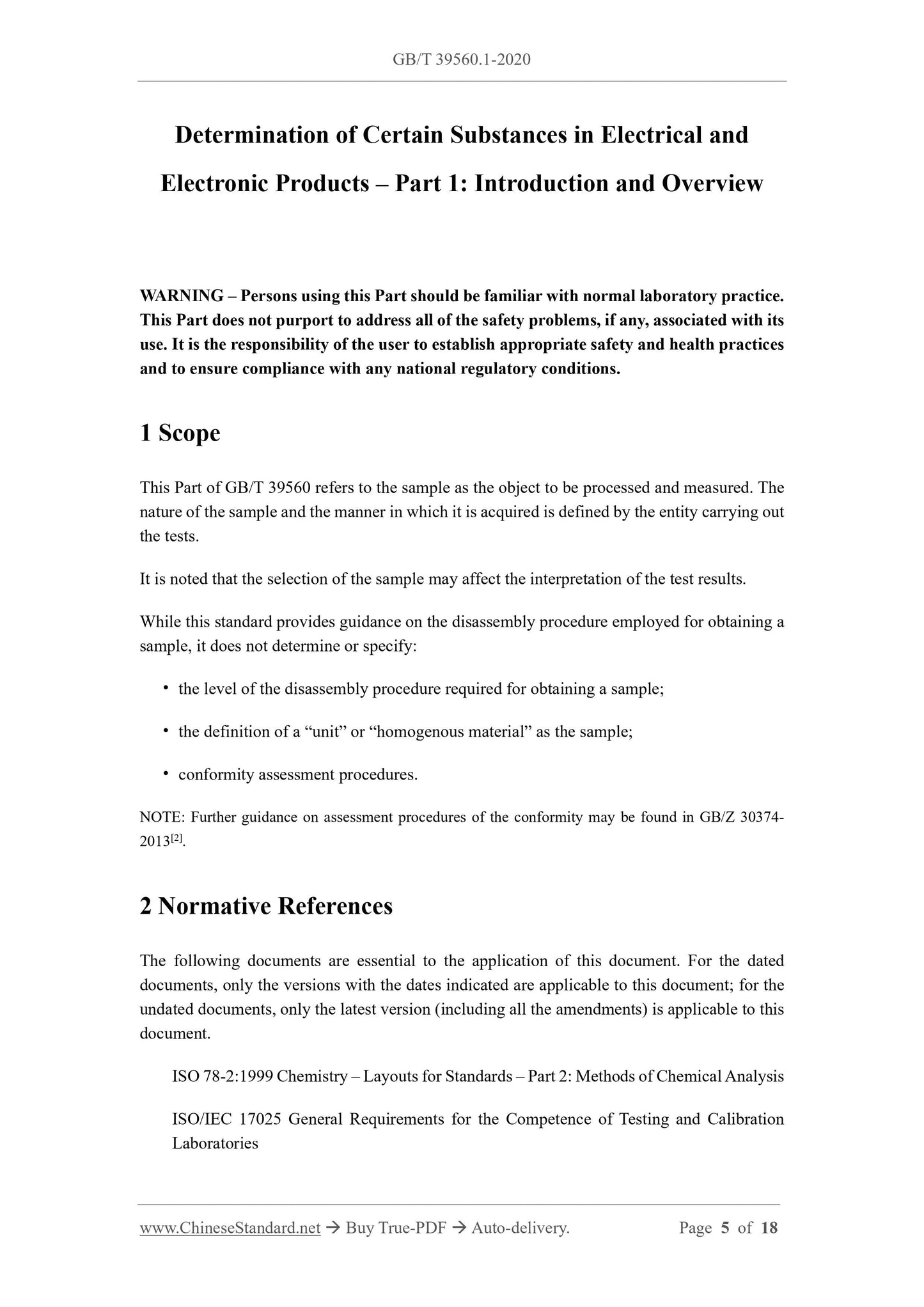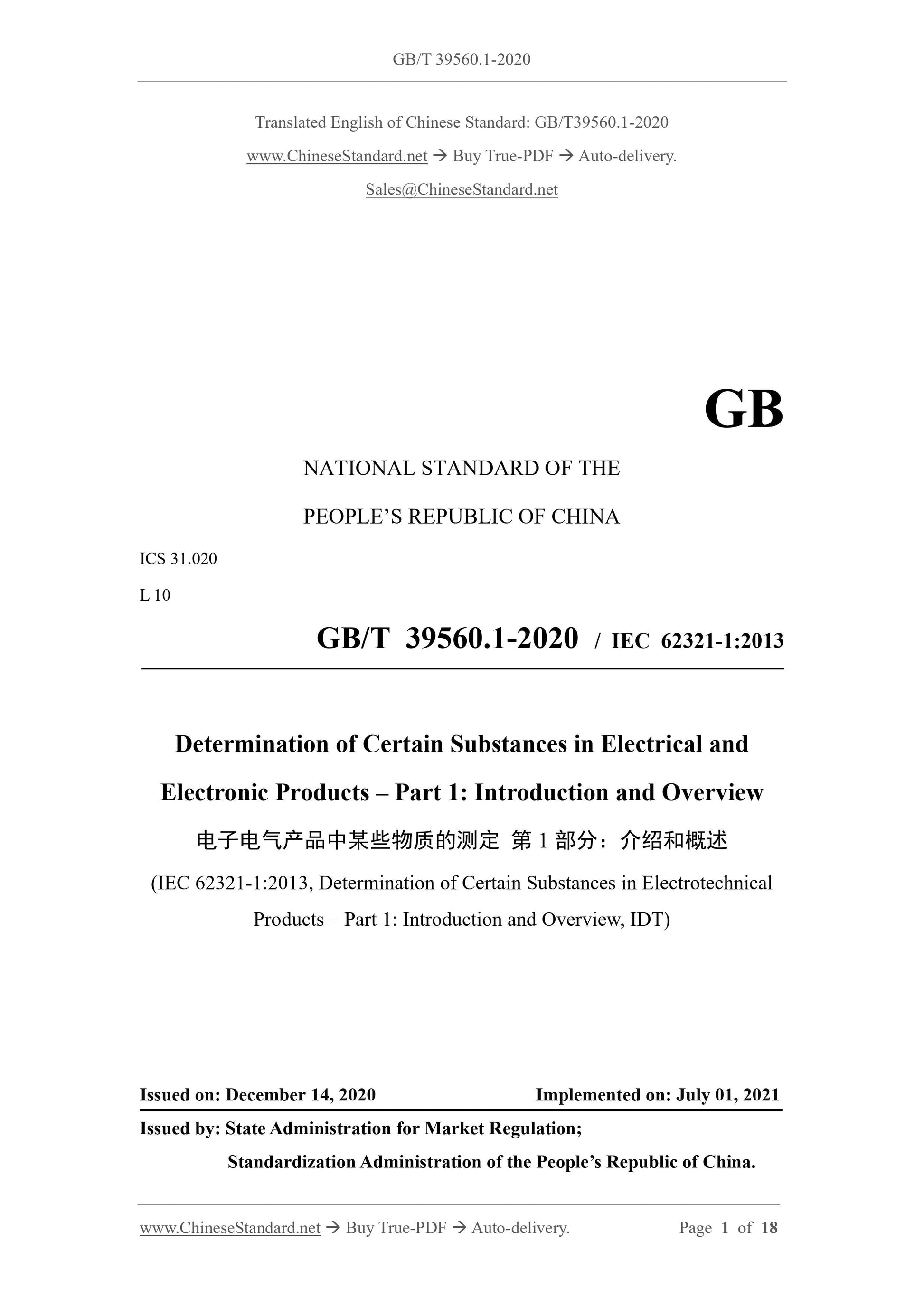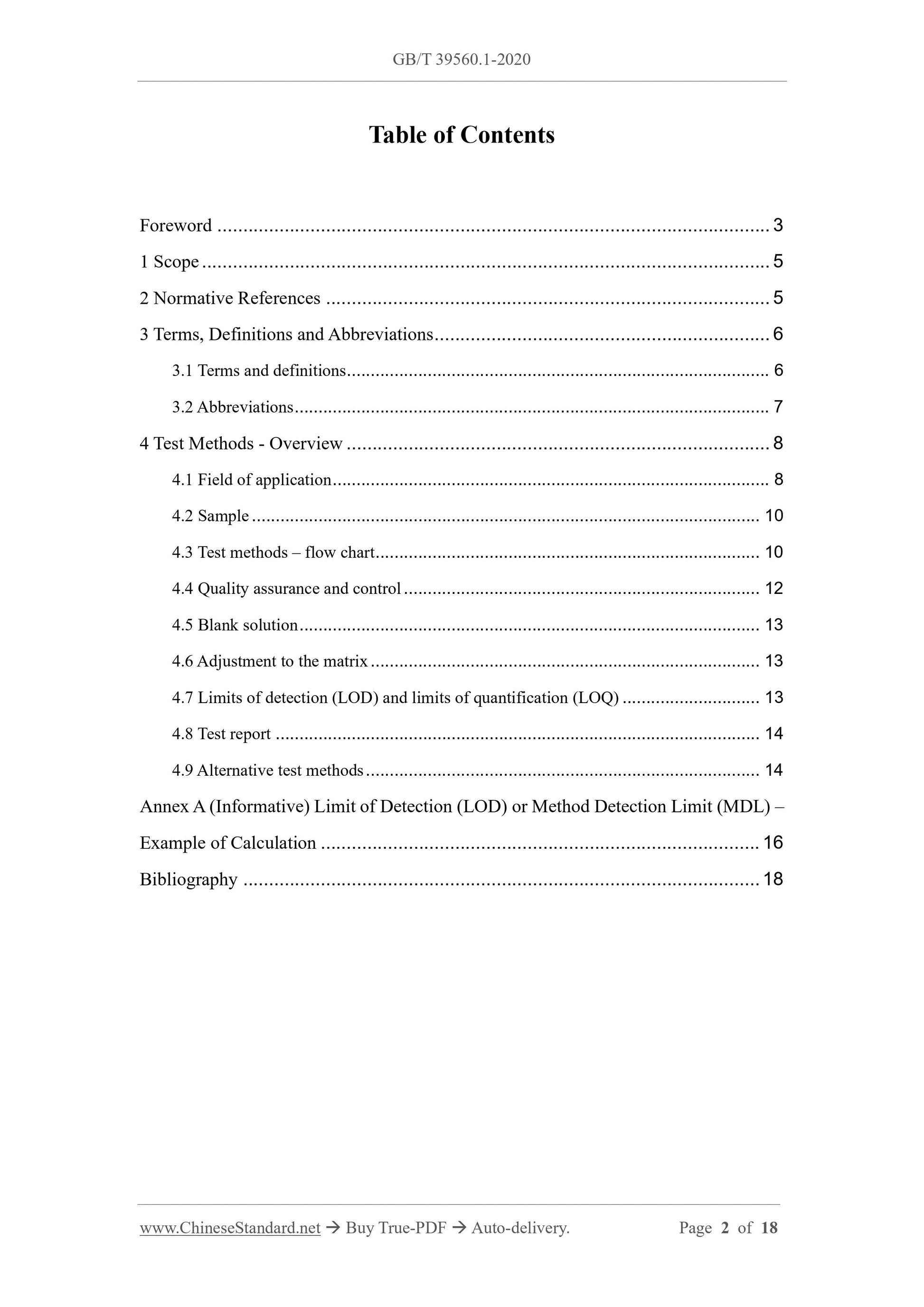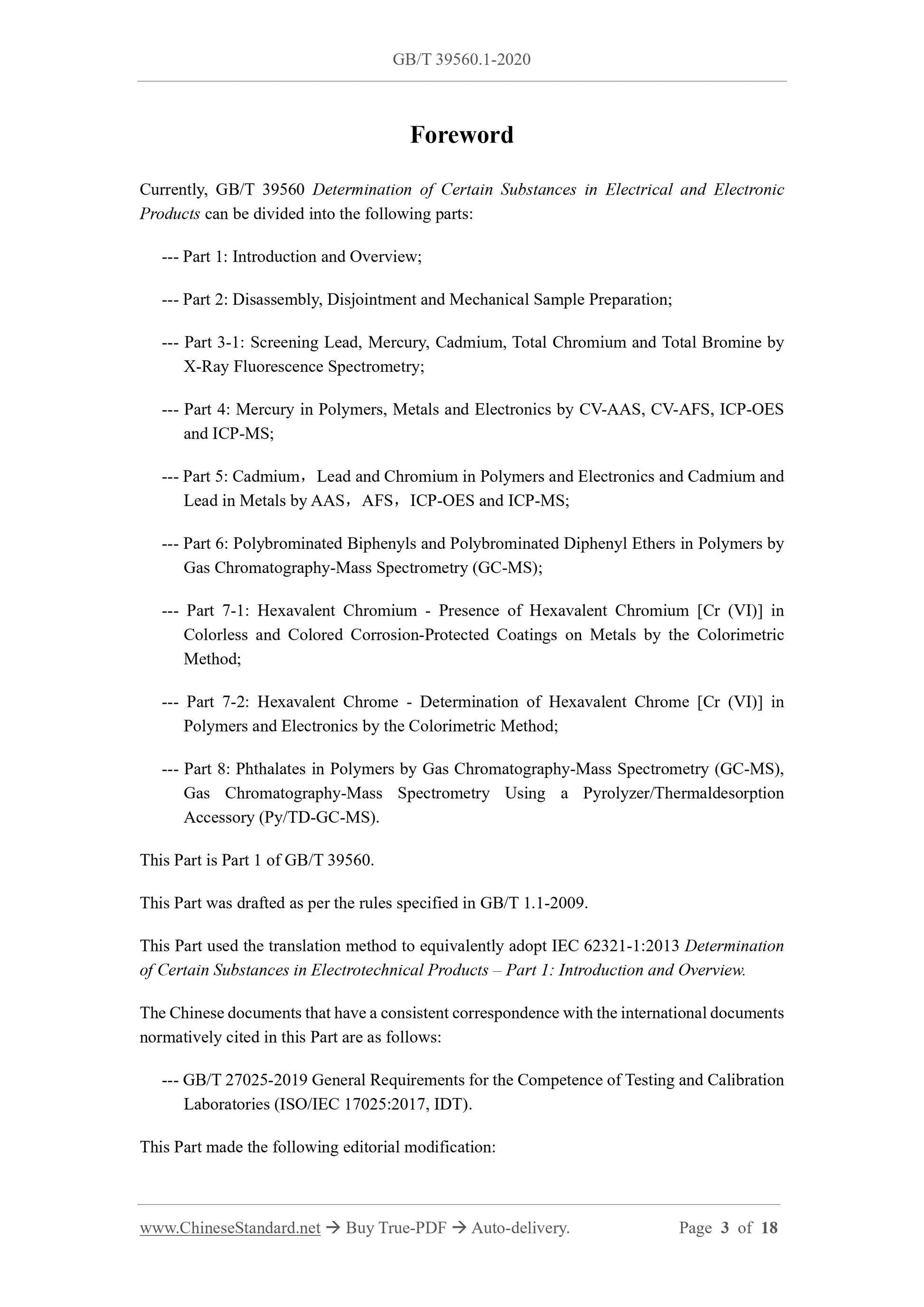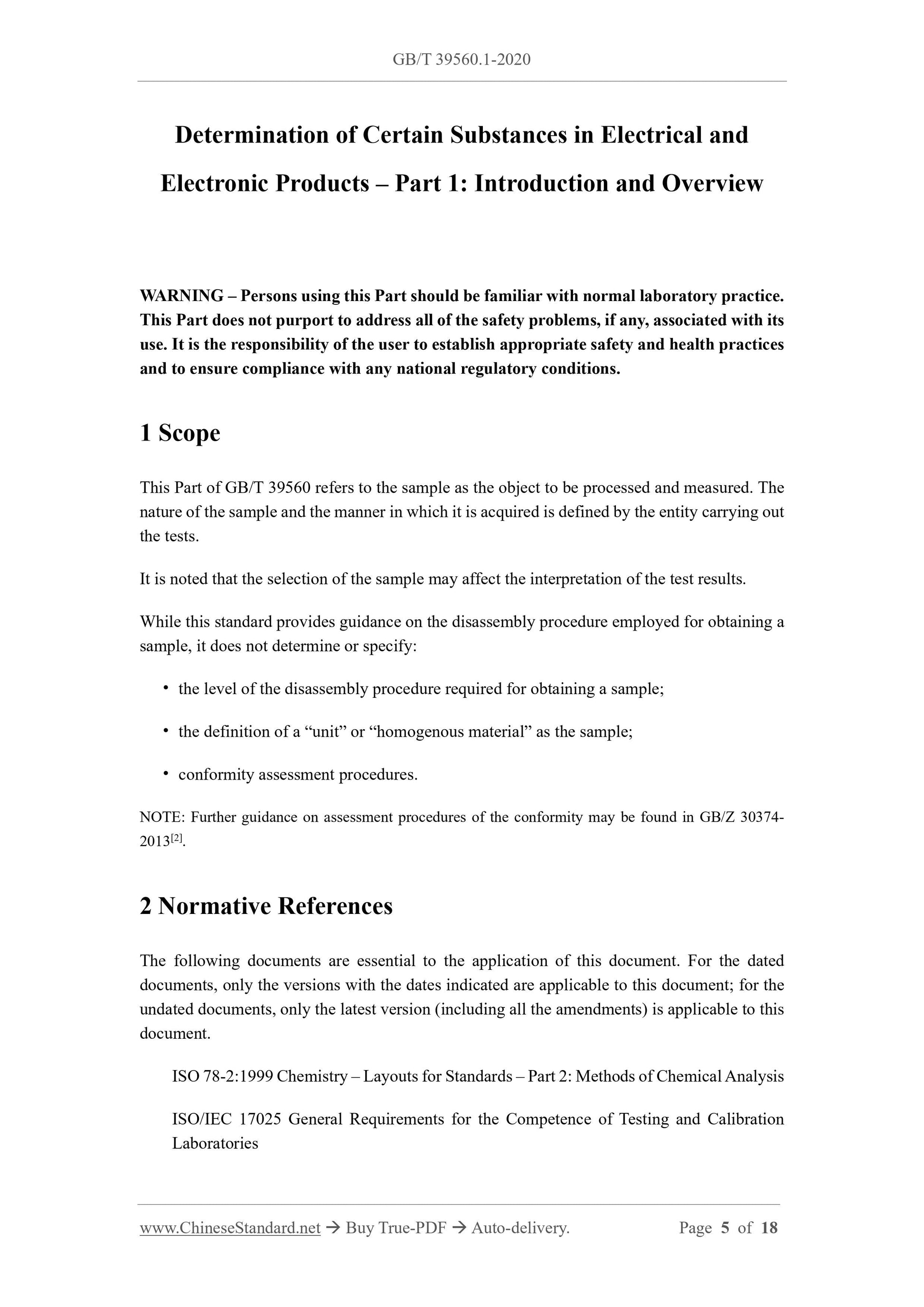1
/
of
4
PayPal, credit cards. Download editable-PDF and invoice in 1 second!
GB/T 39560.1-2020 English PDF (GBT39560.1-2020)
GB/T 39560.1-2020 English PDF (GBT39560.1-2020)
Regular price
$205.00 USD
Regular price
Sale price
$205.00 USD
Unit price
/
per
Shipping calculated at checkout.
Couldn't load pickup availability
Delivery: 3 seconds. Download true-PDF + Invoice.
Get QUOTATION in 1-minute: Click GB/T 39560.1-2020
Historical versions: GB/T 39560.1-2020
Preview True-PDF (Reload/Scroll if blank)
GB/T 39560.1-2020: Determination of certain substances in electrical and electronic products -- Part 1: Introduction and overview
GB/T 39560.1-2020
NATIONAL STANDARD OF THE
PEOPLE’S REPUBLIC OF CHINA
ICS 31.020
L 10
GB/T 39560.1-2020 / IEC 62321-1:2013
Determination of Certain Substances in Electrical and
Electronic Products – Part 1: Introduction and Overview
(IEC 62321-1:2013, Determination of Certain Substances in Electrotechnical
Products – Part 1: Introduction and Overview, IDT)
ISSUED ON: DECEMBER 14, 2020
IMPLEMENTED ON: JULY 01, 2021
Issued by: State Administration for Market Regulation;
Standardization Administration of the People’s Republic of China.
Table of Contents
Foreword ... 3
1 Scope ... 5
2 Normative References ... 5
3 Terms, Definitions and Abbreviations ... 6
3.1 Terms and definitions ... 6
3.2 Abbreviations ... 7
4 Test Methods - Overview ... 8
4.1 Field of application ... 8
4.2 Sample ... 10
4.3 Test methods – flow chart ... 10
4.4 Quality assurance and control ... 12
4.5 Blank solution ... 13
4.6 Adjustment to the matrix ... 13
4.7 Limits of detection (LOD) and limits of quantification (LOQ) ... 13
4.8 Test report ... 14
4.9 Alternative test methods ... 14
Annex A (Informative) Limit of Detection (LOD) or Method Detection Limit (MDL) –
Example of Calculation ... 16
Bibliography ... 18
Determination of Certain Substances in Electrical and
Electronic Products – Part 1: Introduction and Overview
WARNING – Persons using this Part should be familiar with normal laboratory practice.
This Part does not purport to address all of the safety problems, if any, associated with its
use. It is the responsibility of the user to establish appropriate safety and health practices
and to ensure compliance with any national regulatory conditions.
1 Scope
This Part of GB/T 39560 refers to the sample as the object to be processed and measured. The
nature of the sample and the manner in which it is acquired is defined by the entity carrying out
the tests.
It is noted that the selection of the sample may affect the interpretation of the test results.
While this standard provides guidance on the disassembly procedure employed for obtaining a
sample, it does not determine or specify:
• the level of the disassembly procedure required for obtaining a sample;
• the definition of a “unit” or “homogenous material” as the sample;
• conformity assessment procedures.
NOTE: Further guidance on assessment procedures of the conformity may be found in GB/Z 30374-
2013[2].
2 Normative References
The following documents are essential to the application of this document. For the dated
documents, only the versions with the dates indicated are applicable to this document; for the
undated documents, only the latest version (including all the amendments) is applicable to this
document.
ISO 78-2:1999 Chemistry – Layouts for Standards – Part 2: Methods of Chemical Analysis
ISO/IEC 17025 General Requirements for the Competence of Testing and Calibration
Laboratories
Closeness of agreement between independent test results obtained under stipulated conditions.
3.1.7 Reference material
Material, sufficiently homogeneous and stable with reference to specified properties, which has
been established to be fit for its intended use in measurement or in examination of nominal
properties.
3.1.8 Repeatability
Precision under repeatability conditions.
[GB/T 6379.1-2004, definition 3.13] [1]
3.1.9 Reproducibility
Precision under reproducibility conditions.
[GB/T 6379.1-2004, definition 3.17] [1]
3.1.10 Screening
Analytical procedure to determine the presence or absence of substances in the representative
part or section of a product, relative to the value or values chosen as the criterion for presence,
absence or further testing.
NOTE: If the screening method produces values that are not conclusive, then additional analysis or other
follow-up actions may be necessary to make a final presence/absence decision.
3.2 Abbreviations
The following abbreviations are applicable to this Document.
AAS: Atomic Absorption Spectrometry;
C-IC: Combustion - Ion Chromatography;
CV-AAS: Cold Vapour Atomic Absorption Spectrometry;
CV-AFS: Cold Vapour Atomic Fluorescence Spectroscopy;
EPA: Environmental Protection Agency;
FRU: Field Replaceable Unit;
GC-MS: Gas Chromatography - Mass Spectrometry;
GLP: Good Laboratory Practice;
HPLC-UV: High-Performance Liquid Chromatography - Ultraviolet;
IC: Ion Chromatography;
IAMS: Ion Attached Mass Spectrometry;
ICP-MS: Inductively Coupled Plasma Mass Spectrometry;
ICP-OES: Inductively Coupled Plasma Optical Emission Spectrometry;
IS: Internal Standard;
IUPAC: International Union of Pure and Applied Chemistry;
LOD: Limit of Detection;
LOQ: Limit of Quantification;
MDL: Method Detection Limit;
PBB: Polybrominated Biphenyl;
PBDE: Polybrominated Diphenyl Ether;
PBMS: Performance-Based Measurement System;
PWB: Printed Wiring Board;
QC: Quality Control;
UV-VIS: Ultraviolet–Visible Spectroscopy;
XRF: X-Ray Fluorescence Spectroscopy.
4 Test Methods - Overview
4.1 Field of application
The contents of the test methods to determine the levels of certain substances are grouped into
important steps:
a) analytical test methods;
b) laboratory implementation.
Analytical test methods were developed and validated to ensure their suitability to the task. The
structure of each of the test methods are generally aligned in accordance with ISO 78-2:1999
where applicable, i.e.:
hexavalent chromium, etc.) in electrical and electronic equipment is widely used in reference
to analytical testing methods. Screening methods provide the analyst a convenient approach to
evaluate for the presence or quantity of certain substance(s) in samples. Screening may employ
qualitative or semi-quantitative methods. In some cases, a quantitative method may be used for
screening purposes if the actual targeted substance(s) are difficult to analyze directly (e.g.,
hexavalent Cr).
Depending on the screening results however, additional analysis methods may need to be
employed to definitively verify the presence or quantity of certain substances. These definitive
analysis methods are referred to as verification methods.
While X-ray fluorescence spectrometry (XRF) is the tool most commonly associated with the
screening approach, it is not limited to this analytical measurement technique. Users of this
family of standards will understand that multiple measurement techniques can be employed for
the purpose of “screening”.
Screening for hexavalent chromium [Cr(VI)] for example, can be accomplished by a total
chromium measurement using a non-destructive XRF analysis method. Similarly, total
chromium analysis could be performed by a destructive analysis using an inductively coupled
plasma measurement method. Either measurement can be effectively employed to evaluate for
the presence or quantity of hexavalent chromium since the concentration of the hexavalent
species can be no greater than the total chromium concentration value.
Likewise, a total bromine measurement using a non-destructive XRF analysis method or C-IC
method can be used in the same fashion. Either measurement can be effectively employed to
evaluate for the presence or quantity (PBBs) or (PBDEs) in a sample when relating the total
bromine content to the composition of these compounds.
In both examples however, the detection of elevated total element levels requires additional
verification method analysis (e.g., U...
Get QUOTATION in 1-minute: Click GB/T 39560.1-2020
Historical versions: GB/T 39560.1-2020
Preview True-PDF (Reload/Scroll if blank)
GB/T 39560.1-2020: Determination of certain substances in electrical and electronic products -- Part 1: Introduction and overview
GB/T 39560.1-2020
NATIONAL STANDARD OF THE
PEOPLE’S REPUBLIC OF CHINA
ICS 31.020
L 10
GB/T 39560.1-2020 / IEC 62321-1:2013
Determination of Certain Substances in Electrical and
Electronic Products – Part 1: Introduction and Overview
(IEC 62321-1:2013, Determination of Certain Substances in Electrotechnical
Products – Part 1: Introduction and Overview, IDT)
ISSUED ON: DECEMBER 14, 2020
IMPLEMENTED ON: JULY 01, 2021
Issued by: State Administration for Market Regulation;
Standardization Administration of the People’s Republic of China.
Table of Contents
Foreword ... 3
1 Scope ... 5
2 Normative References ... 5
3 Terms, Definitions and Abbreviations ... 6
3.1 Terms and definitions ... 6
3.2 Abbreviations ... 7
4 Test Methods - Overview ... 8
4.1 Field of application ... 8
4.2 Sample ... 10
4.3 Test methods – flow chart ... 10
4.4 Quality assurance and control ... 12
4.5 Blank solution ... 13
4.6 Adjustment to the matrix ... 13
4.7 Limits of detection (LOD) and limits of quantification (LOQ) ... 13
4.8 Test report ... 14
4.9 Alternative test methods ... 14
Annex A (Informative) Limit of Detection (LOD) or Method Detection Limit (MDL) –
Example of Calculation ... 16
Bibliography ... 18
Determination of Certain Substances in Electrical and
Electronic Products – Part 1: Introduction and Overview
WARNING – Persons using this Part should be familiar with normal laboratory practice.
This Part does not purport to address all of the safety problems, if any, associated with its
use. It is the responsibility of the user to establish appropriate safety and health practices
and to ensure compliance with any national regulatory conditions.
1 Scope
This Part of GB/T 39560 refers to the sample as the object to be processed and measured. The
nature of the sample and the manner in which it is acquired is defined by the entity carrying out
the tests.
It is noted that the selection of the sample may affect the interpretation of the test results.
While this standard provides guidance on the disassembly procedure employed for obtaining a
sample, it does not determine or specify:
• the level of the disassembly procedure required for obtaining a sample;
• the definition of a “unit” or “homogenous material” as the sample;
• conformity assessment procedures.
NOTE: Further guidance on assessment procedures of the conformity may be found in GB/Z 30374-
2013[2].
2 Normative References
The following documents are essential to the application of this document. For the dated
documents, only the versions with the dates indicated are applicable to this document; for the
undated documents, only the latest version (including all the amendments) is applicable to this
document.
ISO 78-2:1999 Chemistry – Layouts for Standards – Part 2: Methods of Chemical Analysis
ISO/IEC 17025 General Requirements for the Competence of Testing and Calibration
Laboratories
Closeness of agreement between independent test results obtained under stipulated conditions.
3.1.7 Reference material
Material, sufficiently homogeneous and stable with reference to specified properties, which has
been established to be fit for its intended use in measurement or in examination of nominal
properties.
3.1.8 Repeatability
Precision under repeatability conditions.
[GB/T 6379.1-2004, definition 3.13] [1]
3.1.9 Reproducibility
Precision under reproducibility conditions.
[GB/T 6379.1-2004, definition 3.17] [1]
3.1.10 Screening
Analytical procedure to determine the presence or absence of substances in the representative
part or section of a product, relative to the value or values chosen as the criterion for presence,
absence or further testing.
NOTE: If the screening method produces values that are not conclusive, then additional analysis or other
follow-up actions may be necessary to make a final presence/absence decision.
3.2 Abbreviations
The following abbreviations are applicable to this Document.
AAS: Atomic Absorption Spectrometry;
C-IC: Combustion - Ion Chromatography;
CV-AAS: Cold Vapour Atomic Absorption Spectrometry;
CV-AFS: Cold Vapour Atomic Fluorescence Spectroscopy;
EPA: Environmental Protection Agency;
FRU: Field Replaceable Unit;
GC-MS: Gas Chromatography - Mass Spectrometry;
GLP: Good Laboratory Practice;
HPLC-UV: High-Performance Liquid Chromatography - Ultraviolet;
IC: Ion Chromatography;
IAMS: Ion Attached Mass Spectrometry;
ICP-MS: Inductively Coupled Plasma Mass Spectrometry;
ICP-OES: Inductively Coupled Plasma Optical Emission Spectrometry;
IS: Internal Standard;
IUPAC: International Union of Pure and Applied Chemistry;
LOD: Limit of Detection;
LOQ: Limit of Quantification;
MDL: Method Detection Limit;
PBB: Polybrominated Biphenyl;
PBDE: Polybrominated Diphenyl Ether;
PBMS: Performance-Based Measurement System;
PWB: Printed Wiring Board;
QC: Quality Control;
UV-VIS: Ultraviolet–Visible Spectroscopy;
XRF: X-Ray Fluorescence Spectroscopy.
4 Test Methods - Overview
4.1 Field of application
The contents of the test methods to determine the levels of certain substances are grouped into
important steps:
a) analytical test methods;
b) laboratory implementation.
Analytical test methods were developed and validated to ensure their suitability to the task. The
structure of each of the test methods are generally aligned in accordance with ISO 78-2:1999
where applicable, i.e.:
hexavalent chromium, etc.) in electrical and electronic equipment is widely used in reference
to analytical testing methods. Screening methods provide the analyst a convenient approach to
evaluate for the presence or quantity of certain substance(s) in samples. Screening may employ
qualitative or semi-quantitative methods. In some cases, a quantitative method may be used for
screening purposes if the actual targeted substance(s) are difficult to analyze directly (e.g.,
hexavalent Cr).
Depending on the screening results however, additional analysis methods may need to be
employed to definitively verify the presence or quantity of certain substances. These definitive
analysis methods are referred to as verification methods.
While X-ray fluorescence spectrometry (XRF) is the tool most commonly associated with the
screening approach, it is not limited to this analytical measurement technique. Users of this
family of standards will understand that multiple measurement techniques can be employed for
the purpose of “screening”.
Screening for hexavalent chromium [Cr(VI)] for example, can be accomplished by a total
chromium measurement using a non-destructive XRF analysis method. Similarly, total
chromium analysis could be performed by a destructive analysis using an inductively coupled
plasma measurement method. Either measurement can be effectively employed to evaluate for
the presence or quantity of hexavalent chromium since the concentration of the hexavalent
species can be no greater than the total chromium concentration value.
Likewise, a total bromine measurement using a non-destructive XRF analysis method or C-IC
method can be used in the same fashion. Either measurement can be effectively employed to
evaluate for the presence or quantity (PBBs) or (PBDEs) in a sample when relating the total
bromine content to the composition of these compounds.
In both examples however, the detection of elevated total element levels requires additional
verification method analysis (e.g., U...
Share
